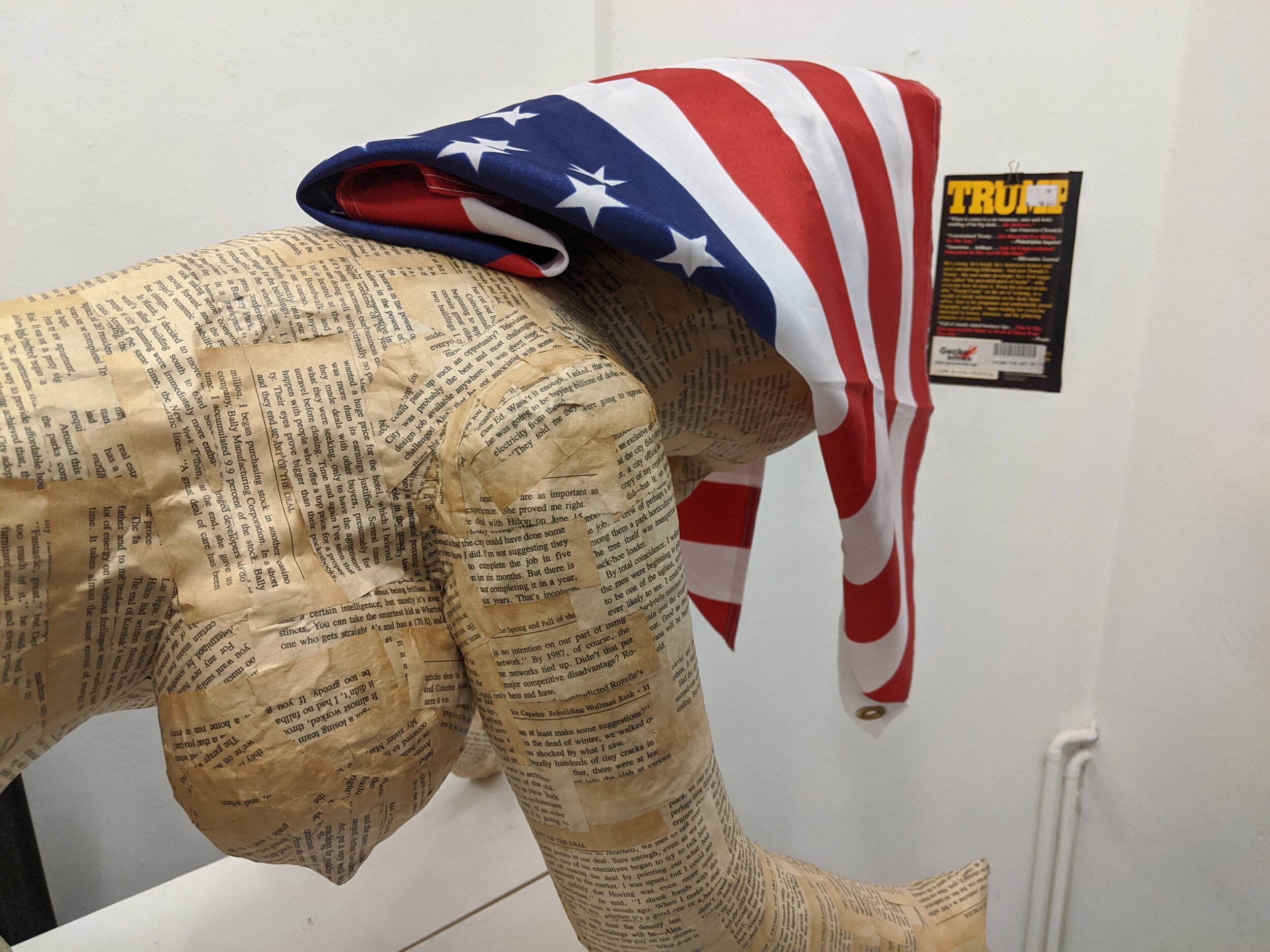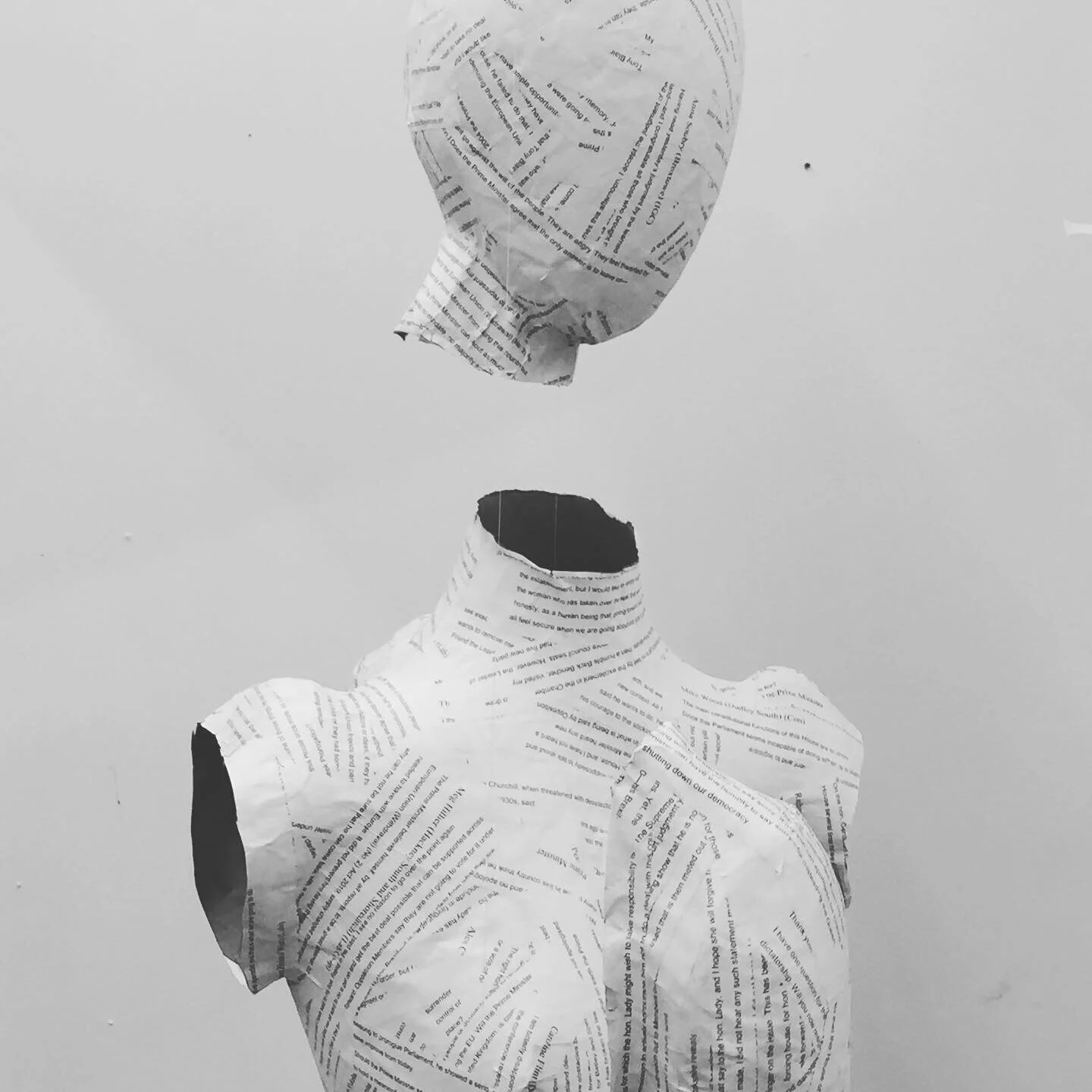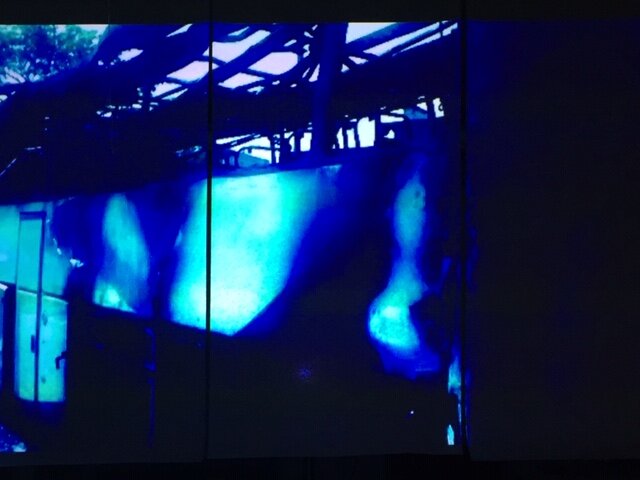
The crouching figure, a three-orifice sex doll, her skin composed of fragments of the 1987 book The Art of the Deal by Tony Schwarz and Donald Trump, is displayed sheltering from Trump’s misogyny and narcissism under the federal flag of the United States of America. The title is a sentence taken from the book.
Mixed media | 60 x 44 x 100 cm

Mixed media | 60 x 44 x 100 cm

Mixed media | 60 x 44 x 100 cm

Mixed media | 60 x 44 x 100 cm

A dismembered paper doll’s outer layer is composed of the pages of Hansard – the official record of the proceedings of the United Kingdom’s two houses of parliament, the Commons (the elected lower house) and the Lords (the unelected upper house) – together with fragments of posters discarded in the streets of Westminster after a one-million-strong demonstration held on 19 October 2019 in support of a further referendum, otherwise known as The People’s Vote.
The parliamentary debate recorded in these particular pages of Hansard is the Prime Minister’s Statement to the House of Commons of 25 September 2019, which began at 6.30 pm. This was Johnson’s first appearance before a Parliament which had that day been reopened following a ruling by the UK Supreme Court that his decision to prorogue (a procedure to close Parliament normally only applied a few days prior to The Sovereign’s speech setting out the government’s new legislative programme) was unlawful.
The language used in that debate, and the utterances of Prime Minister Boris Johnson in particular, shocked observers and resulted in impassioned pleas for moderation of tone. Links have often been made between the use of language by politicians and the media and the frequency of death threats or intimidation directed towards sitting Members of Parliament and particularly women MPs
The title of this piece refers to the EU Withdrawal (No. 2) Act (otherwise known as the Benn Act, after its instigator), which required the Prime Minister to ask the EU for an extension to the Article 50 negotiating period, thus avoiding a ‘no-deal’ Brexit on 31 October. During the 25 September debate, Johnson frequently referred to this legislation as ‘The Surrender Act’ and repeatedly used the words ‘surrender’, ‘betrayal’ and ‘traitor’ to cast a populist, rhetorical narrative of ‘the people versus parliament’.
There was widespread consternation in the Commons Chamber, most notably from Paula Sherriff, MP for Dewsbury in West Yorkshire, who decried Johnson’s words as ‘offensive, dangerous and inflammatory’. She also made specific reference to the murder in 2016 of her former colleague Jo Cox, MP for her neighbouring constituency of Batley and Spen, by a far-right terrorist during the 2016 Brexit referendum. In response to Sherriff’s appeal to calm and reason, Johnson replied using the word ‘humbug’.
Paper | 250 x 30 x 70 cm (kinetic, dimensions vary)

Paper | 250 x 30 x 70 cm (kinetic, dimensions vary)

Paper | 250 x 30 x 70 cm (kinetic, dimensions vary)

Paper | 250 x 30 x 70 cm (kinetic, dimensions vary)

Paper | 250 x 30 x 70 cm (kinetic, dimensions vary)

The outer surface of the work is a collage of pages from And Tango Makes Three, a children’s book based on the true story of penguins in New York City’s Central Park Zoo (Peter Parnell and Justin Richardson, illustrated by Henry Cole, Simon & Schuster 2005). And Tango Makes Three, a standard-bearer for same-sex parenting, has either been banned or quietly moved away from the children’s sections of numerous libraries around the world, particularly in the US. In this version of the story, the character Silo has been taken to a prison camp, and he and his life-partner Roy forcibly separated. Their chick Tango will no longer be hatched by them. Silo stands on two bricks taken from a skip; many of the homosexual prisoners who were taken to Sachsenhausen concentration camp from 1933 onward worked as slave labourers in the brickworks. Given the vintage of these bricks, and without forensic examination, it should be assumed that it is possible that this is how these bricks were made.
Paper, found objects | 51 x 16 x 27 cm

Paper, found objects | 51 x 16 x 27 cm

This work’s title refers to a claim by Alternative for Germany (AfD) that Die Wende – Germany’s period of change as it moved from partition to reunification – is an incomplete process.
The trigger mechanism and base plate of the rat trap it features remind us of the right-wing populist party’s logotype, while the feather inside the rat trap refers both to AfD figure Björn Höcke’s Der Flügel (the Wing) faction and to the power of the quill to distort truth as well as elucidate. This rat trap is designed to take its victims alive.
Mixed media 13 x 11 x 37 cm

Mixed media 13 x 11 x 37 cm

In his 2019 volume of short stories and vignettes, German author Ferdinand von Schirach draws his readers’ attention to the fact that the English words ‘silent’ and ‘listen’ are composed of the same letters.
The work draws attention to the dilemmas of engaging in dialogue with people who hold very different views to our own, and it serves as an analogue counterpoint to the algorithms used by social media platforms that have driven users into like-minded silos.
Mixed media with power and light | 30 x 60 x 70 cm Constructed by : Martin Sona

Mixed media with power and light | 30 x 60 x 70 cm

Mixed media with power and light | 30 x 60 x 70 cm

The title, meaning ‘blood and soil’, refers to the Nazi concept of a mythical, ethnic and cultural purity that emanates from a close connection between a racially pure people and the land they inhabit. While the reference is inherently agrarian, the concept also contains an implicit threat to outsiders. The quotation ‘Qu'un sang impur/ Abreuve nos sillons!’ (Let impure blood/ Irrigate our furrows!) is from the refrain of the French national anthem, the Marseillaise. These two lines of the anthem endure in the song despite a 1992 campaign, supported by the former French president Valérie Giscard d’Estaing, to have them rewritten.
The colour in the work refers to the Nazi’s adoption of red, white and black, a trio that has reappeared on the streets of many German cities in far-right demonstrations. By changing only one colour in the German Federal Republic’s Schwartz-Rot-Gold (black, red, gold) sequence, far-right protestors are making a direct reference to the Third Reich and simultaneously raise the possibility of there being a fourth. A similar reference can be made to Vichy France by substituting black for blue in the French tricolore.
Acrylic, with power and light
750 x 1500 x 1792 mm, constructed by : Martin Sona

Acrylic, with power and light 750 x 1500 x 1792 mm, constructed by : Martin Sona

Acrylic, with power and light 750 x 1500 x 1792 mm, constructed by : Martin Sona

On two separate occasions, two years apart, Jonathan Davis came across a burned-out coach in the bus station of the Franco-Swiss border town of Annemasse. The sense of déjà vu engendered by this coincidence deeply perturbed the artist.
Annemasse, in the French department of Haute-Savoie (which has numerous ski resorts), is an arrival and departure point for migrant workers, most of whom are presumably en route to take up work in the Canton of Geneva and the wider Swiss labour market. The coaches arriving and departing here travel to countries such as Morocco, Poland and Portugal. These arson attacks are assumed to be hate crimes directed at migrant workers, and initial newspaper reports speak of ‘ensuing police investigations’. However, research undertaken by the artist revealed no record of any police follow-up.
Several aspects of these events form a disturbing picture: there were two events, nearly two years apart; the bus station at Annemasse is adjacent to a police station; no visible attempt was made to secure the site so as to perform forensic investigations; and no surveillance equipment has subsequently been installed.
Projection on paper in segments of 5 x 46 cm
Found object, candles, 52 photographs, dimensions vary
Graphics by : Javier Escorcia

Projection on paper in segments of 5 x 46 cm Found object, candles, 52 photographs, dimensions vary

Projection on paper in segments of 5 x 46 cm Found object, candles, 52 photographs, dimensions vary

Projection on paper in segments of 5 x 46 cm Found object, candles, 52 photographs, dimensions vary

Projection on paper in segments of 5 x 46 cm Found object, candles, 52 photographs, dimensions vary
























The crouching figure, a three-orifice sex doll, her skin composed of fragments of the 1987 book The Art of the Deal by Tony Schwarz and Donald Trump, is displayed sheltering from Trump’s misogyny and narcissism under the federal flag of the United States of America. The title is a sentence taken from the book.
Mixed media | 60 x 44 x 100 cm
Mixed media | 60 x 44 x 100 cm
Mixed media | 60 x 44 x 100 cm
Mixed media | 60 x 44 x 100 cm
A dismembered paper doll’s outer layer is composed of the pages of Hansard – the official record of the proceedings of the United Kingdom’s two houses of parliament, the Commons (the elected lower house) and the Lords (the unelected upper house) – together with fragments of posters discarded in the streets of Westminster after a one-million-strong demonstration held on 19 October 2019 in support of a further referendum, otherwise known as The People’s Vote.
The parliamentary debate recorded in these particular pages of Hansard is the Prime Minister’s Statement to the House of Commons of 25 September 2019, which began at 6.30 pm. This was Johnson’s first appearance before a Parliament which had that day been reopened following a ruling by the UK Supreme Court that his decision to prorogue (a procedure to close Parliament normally only applied a few days prior to The Sovereign’s speech setting out the government’s new legislative programme) was unlawful.
The language used in that debate, and the utterances of Prime Minister Boris Johnson in particular, shocked observers and resulted in impassioned pleas for moderation of tone. Links have often been made between the use of language by politicians and the media and the frequency of death threats or intimidation directed towards sitting Members of Parliament and particularly women MPs
The title of this piece refers to the EU Withdrawal (No. 2) Act (otherwise known as the Benn Act, after its instigator), which required the Prime Minister to ask the EU for an extension to the Article 50 negotiating period, thus avoiding a ‘no-deal’ Brexit on 31 October. During the 25 September debate, Johnson frequently referred to this legislation as ‘The Surrender Act’ and repeatedly used the words ‘surrender’, ‘betrayal’ and ‘traitor’ to cast a populist, rhetorical narrative of ‘the people versus parliament’.
There was widespread consternation in the Commons Chamber, most notably from Paula Sherriff, MP for Dewsbury in West Yorkshire, who decried Johnson’s words as ‘offensive, dangerous and inflammatory’. She also made specific reference to the murder in 2016 of her former colleague Jo Cox, MP for her neighbouring constituency of Batley and Spen, by a far-right terrorist during the 2016 Brexit referendum. In response to Sherriff’s appeal to calm and reason, Johnson replied using the word ‘humbug’.
Paper | 250 x 30 x 70 cm (kinetic, dimensions vary)
Paper | 250 x 30 x 70 cm (kinetic, dimensions vary)
Paper | 250 x 30 x 70 cm (kinetic, dimensions vary)
Paper | 250 x 30 x 70 cm (kinetic, dimensions vary)
Paper | 250 x 30 x 70 cm (kinetic, dimensions vary)
The outer surface of the work is a collage of pages from And Tango Makes Three, a children’s book based on the true story of penguins in New York City’s Central Park Zoo (Peter Parnell and Justin Richardson, illustrated by Henry Cole, Simon & Schuster 2005). And Tango Makes Three, a standard-bearer for same-sex parenting, has either been banned or quietly moved away from the children’s sections of numerous libraries around the world, particularly in the US. In this version of the story, the character Silo has been taken to a prison camp, and he and his life-partner Roy forcibly separated. Their chick Tango will no longer be hatched by them. Silo stands on two bricks taken from a skip; many of the homosexual prisoners who were taken to Sachsenhausen concentration camp from 1933 onward worked as slave labourers in the brickworks. Given the vintage of these bricks, and without forensic examination, it should be assumed that it is possible that this is how these bricks were made.
Paper, found objects | 51 x 16 x 27 cm
Paper, found objects | 51 x 16 x 27 cm
This work’s title refers to a claim by Alternative for Germany (AfD) that Die Wende – Germany’s period of change as it moved from partition to reunification – is an incomplete process.
The trigger mechanism and base plate of the rat trap it features remind us of the right-wing populist party’s logotype, while the feather inside the rat trap refers both to AfD figure Björn Höcke’s Der Flügel (the Wing) faction and to the power of the quill to distort truth as well as elucidate. This rat trap is designed to take its victims alive.
Mixed media 13 x 11 x 37 cm
Mixed media 13 x 11 x 37 cm
In his 2019 volume of short stories and vignettes, German author Ferdinand von Schirach draws his readers’ attention to the fact that the English words ‘silent’ and ‘listen’ are composed of the same letters.
The work draws attention to the dilemmas of engaging in dialogue with people who hold very different views to our own, and it serves as an analogue counterpoint to the algorithms used by social media platforms that have driven users into like-minded silos.
Mixed media with power and light | 30 x 60 x 70 cm Constructed by : Martin Sona
Mixed media with power and light | 30 x 60 x 70 cm
Mixed media with power and light | 30 x 60 x 70 cm
The title, meaning ‘blood and soil’, refers to the Nazi concept of a mythical, ethnic and cultural purity that emanates from a close connection between a racially pure people and the land they inhabit. While the reference is inherently agrarian, the concept also contains an implicit threat to outsiders. The quotation ‘Qu'un sang impur/ Abreuve nos sillons!’ (Let impure blood/ Irrigate our furrows!) is from the refrain of the French national anthem, the Marseillaise. These two lines of the anthem endure in the song despite a 1992 campaign, supported by the former French president Valérie Giscard d’Estaing, to have them rewritten.
The colour in the work refers to the Nazi’s adoption of red, white and black, a trio that has reappeared on the streets of many German cities in far-right demonstrations. By changing only one colour in the German Federal Republic’s Schwartz-Rot-Gold (black, red, gold) sequence, far-right protestors are making a direct reference to the Third Reich and simultaneously raise the possibility of there being a fourth. A similar reference can be made to Vichy France by substituting black for blue in the French tricolore.
Acrylic, with power and light
750 x 1500 x 1792 mm, constructed by : Martin Sona
Acrylic, with power and light 750 x 1500 x 1792 mm, constructed by : Martin Sona
Acrylic, with power and light 750 x 1500 x 1792 mm, constructed by : Martin Sona
On two separate occasions, two years apart, Jonathan Davis came across a burned-out coach in the bus station of the Franco-Swiss border town of Annemasse. The sense of déjà vu engendered by this coincidence deeply perturbed the artist.
Annemasse, in the French department of Haute-Savoie (which has numerous ski resorts), is an arrival and departure point for migrant workers, most of whom are presumably en route to take up work in the Canton of Geneva and the wider Swiss labour market. The coaches arriving and departing here travel to countries such as Morocco, Poland and Portugal. These arson attacks are assumed to be hate crimes directed at migrant workers, and initial newspaper reports speak of ‘ensuing police investigations’. However, research undertaken by the artist revealed no record of any police follow-up.
Several aspects of these events form a disturbing picture: there were two events, nearly two years apart; the bus station at Annemasse is adjacent to a police station; no visible attempt was made to secure the site so as to perform forensic investigations; and no surveillance equipment has subsequently been installed.
Projection on paper in segments of 5 x 46 cm
Found object, candles, 52 photographs, dimensions vary
Graphics by : Javier Escorcia
Projection on paper in segments of 5 x 46 cm Found object, candles, 52 photographs, dimensions vary
Projection on paper in segments of 5 x 46 cm Found object, candles, 52 photographs, dimensions vary
Projection on paper in segments of 5 x 46 cm Found object, candles, 52 photographs, dimensions vary
Projection on paper in segments of 5 x 46 cm Found object, candles, 52 photographs, dimensions vary
